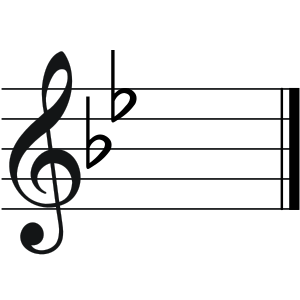Key (music) facts for kids
In music, the key of a song or piece is like its musical "home base." It's a special group of notes, also called a scale, that forms the main sound of the music. Most pop songs and classical music use a key.
This group of notes has a main note called the tonic. It also has a main chord called the tonic chord. When you hear the tonic note or chord, the music feels settled and "at home." Other notes and chords in the song create different feelings, like tension or excitement. These feelings usually get resolved when the music returns to the tonic note or chord.
A key can be in a major or minor mode. Major keys often sound bright and happy, while minor keys can sound more serious or sad. If someone says, "This song is in C," they usually mean C major. Longer classical pieces might even change keys in different sections to create variety.
Contents
What is a Musical Key?
A musical key is the central group of notes that a song is built around. Think of it as the main color palette an artist uses for a painting. All the other notes and chords in the song relate back to this main group. This helps the music sound organized and pleasing to our ears.
The Tonic: Your Musical Home
Every key has a special note called the tonic. This is the "home note" of the key. It's the note that sounds most stable and complete. When a song ends, it usually finishes on the tonic note or a chord built on the tonic. This gives you a feeling of musical rest and completion.
For example, if a song is in the key of C major, the note C is the tonic. The C major chord would be the tonic chord. All the other notes and chords in the song will lead back to C, making it feel like the musical center.
Major and Minor Keys
Keys come in two main types: major and minor.
- Major keys often sound bright, happy, or uplifting. They are commonly used in many pop songs and cheerful classical pieces.
- Minor keys tend to sound more serious, sad, or mysterious. They are used to create different moods and emotions in music.
The difference between a major and minor key comes from the specific pattern of notes in their scales. Even though they share the same tonic note, a C major scale sounds very different from a C minor scale.
How Keys Work in Music
When a composer writes a song in a certain key, they mostly use notes from that key's scale. This creates a consistent sound. However, they can also use notes from outside the key to add interest or create tension. This tension then usually resolves back to the notes of the main key.
Many songs, especially in popular music and classical music from the common practice period (around 1650 to 1900), are written in a specific key. This helps give the music a clear structure and a sense of direction.
Related Musical Ideas
- circle of fifths: A diagram that shows the relationships between different keys.
- tonality: The system where music is organized around a central key or tonic.
- key signature: The sharps or flats written at the beginning of a piece of music that tell you what key it's in.
- transposing instrument: An instrument that sounds a different note than the one written on the music.
Images for kids




